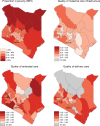Poor Quality for Poor Women? Inequities in the Quality of Antenatal and Delivery Care in Kenya
- PMID: 28141840
- PMCID: PMC5283741
- DOI: 10.1371/journal.pone.0171236
Poor Quality for Poor Women? Inequities in the Quality of Antenatal and Delivery Care in Kenya
Abstract
Background: Quality of healthcare is an important determinant of future progress in global health. However, the distributional aspects of quality of care have received inadequate attention. We assessed whether high quality maternal care is equitably distributed by (1) mapping the quality of maternal care in facilities located in poorer versus wealthier areas of Kenya; and (2) comparing the quality of maternal care available to Kenyans in and not in poverty.
Methods: We assessed three measures of maternal care quality: facility infrastructure and clinical quality of antenatal care and delivery care, using indicators from the 2010 Kenya Service Provision Assessment (SPA), a standardized facility survey with direct observation of maternal care provision. We calculated poverty of the area served by antenatal or delivery care facilities using the Multidimensional Poverty Index. We used regression analyses and non-parametric tests to assess differences in maternal care quality in facilities located in more and less impoverished areas. We estimated effective coverage with a minimum standard of care for the full population and those in poverty.
Results: A total of 564 facilities offering at least one maternal care service were included in this analysis. Quality of maternal care was low, particularly clinical quality of antenatal and delivery care, which averaged 0.52 and 0.58 out of 1 respectively, compared to 0.68 for structural inputs to care. Maternal healthcare quality varied by poverty level: at the facility level, all quality metrics were lowest for the most impoverished areas and increased significantly with greater wealth. Population access to a minimum standard (≥0.75 of 1.00) of quality maternal care was both low and inequitable: only 17% of all women and 8% of impoverished women had access to minimally adequate delivery care.
Conclusion: The quality of maternal care is low in Kenya, and care available to the impoverished is significantly worse than that for the better off. To achieve the national targets of maternal and neonatal mortality reduction, policy initiatives need to tackle low quality of care, starting with high-poverty areas.
Conflict of interest statement
The authors have declared that no competing interests exist.
Figures



References
-
- Souza JP, Gulmezoglu AM, Vogel J, Carroli G, Lumbiganon P, Qureshi Z, et al. Moving beyond essential interventions for reduction of maternal mortality (the WHO Multicountry Survey on Maternal and Newborn Health): a cross-sectional study. Lancet. 2013;381(9879):1747–55. 10.1016/S0140-6736(13)60686-8 - DOI - PubMed
-
- United Nations. The Millennium Development Goals Report 2015. New York, New York: United Nations, 2015.
-
- van den Broek NR, Graham WJ. Quality of care for maternal and newborn health: the neglected agenda. Bjog. 2009;116 Suppl 1:18–21. Epub 2009/09/26. - PubMed
-
- World Bank. World Development Indicators. Washington, DC: World Bank, 2014 2014. Report No.
-
- World Health Organization. Global Health Observatory Data Repository. Geneva, Switzerland: World Health Organization, 2015.
MeSH terms
LinkOut - more resources
Full Text Sources
Other Literature Sources
Medical

